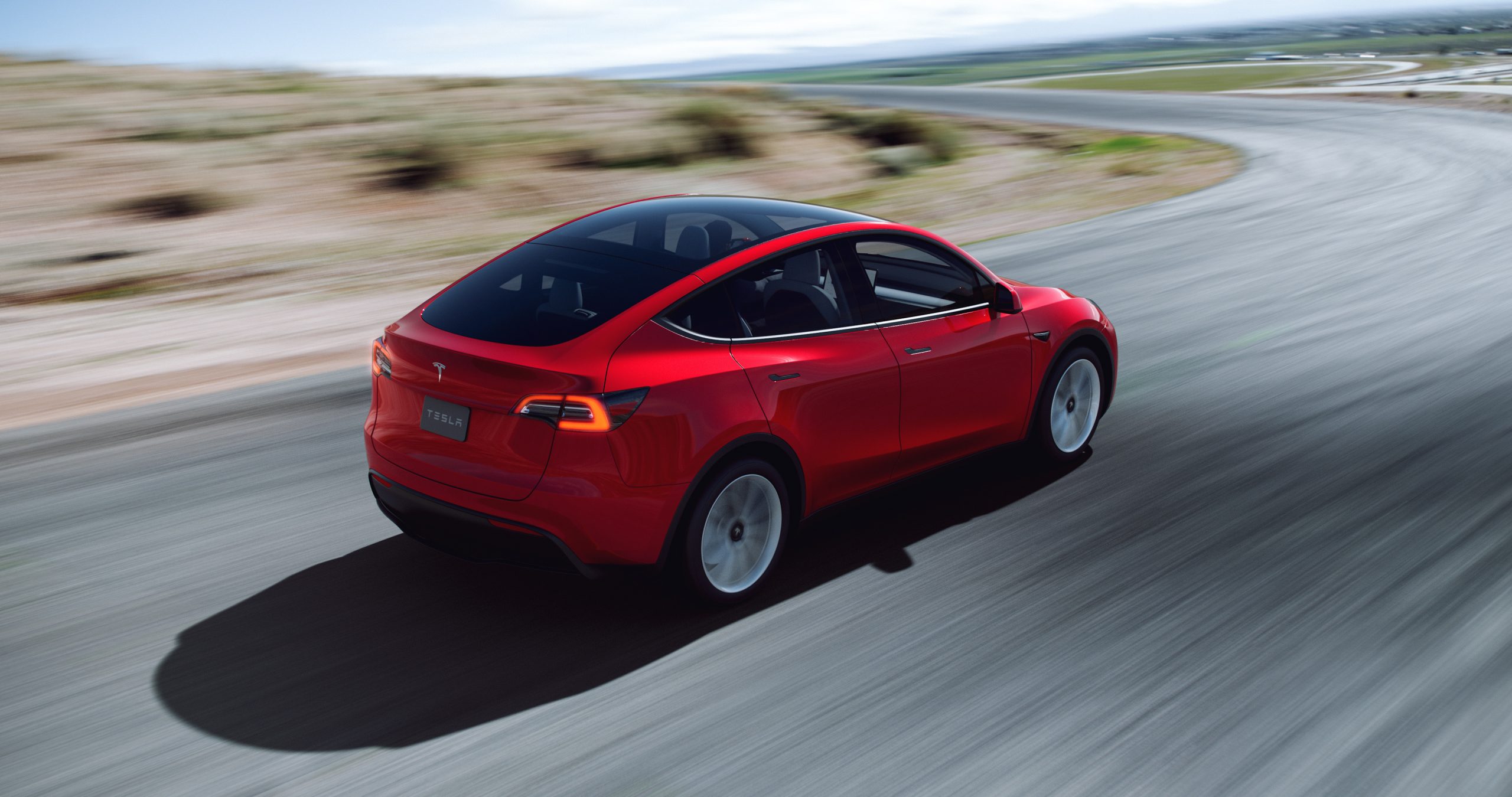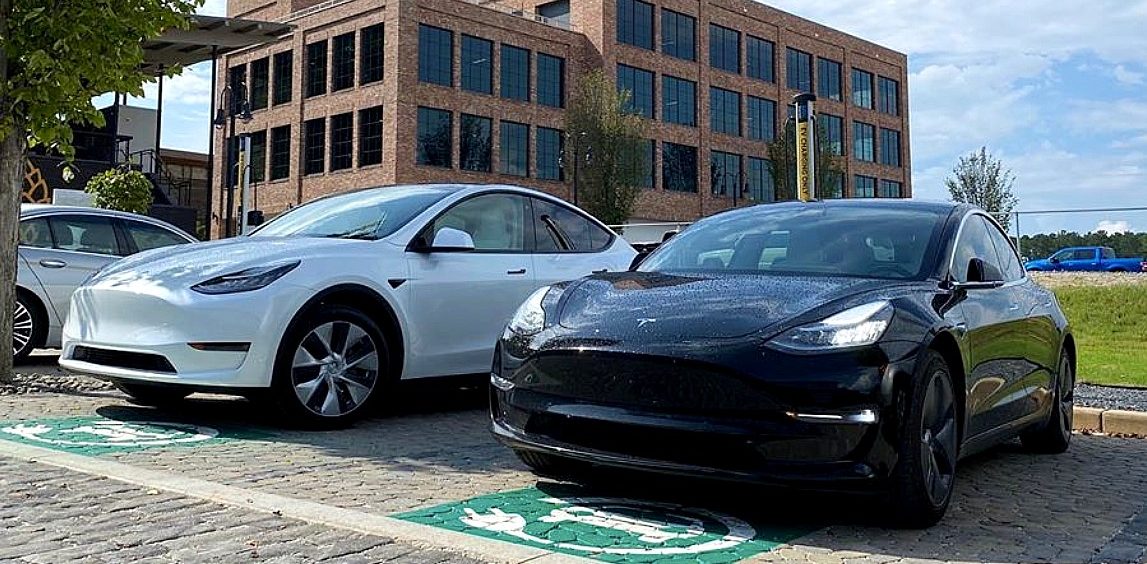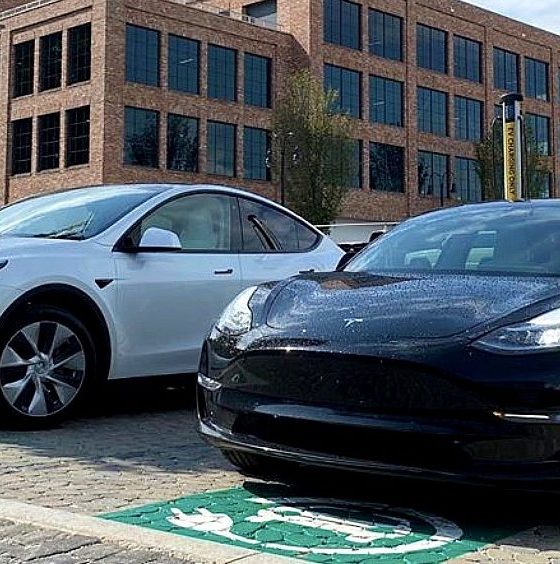Tesla is continuing to solidify itself in the pole position in Norway. New figures from the Norweigian Information Council for Road Traffic (OFV) show the Tesla Model Y and Tesla Model 3 were the country’s two best-selling vehicles in November, making way for Tesla to become the best-selling car brand in the highly competitive market for electric cars.
The Model Y was the best-selling car in Norway in November, selling 1,013 units during the month, according to OFV information. The Model 3 was second with 771 units solid, and the Volkswagen ID.4 came in third with 725 units sold.
The Tesla Model Y all-electric crossover was Norway’s best-selling vehicle in November. (Credit: Tesla)
Norway is arguably the most challenging market in the world for electric automakers. The concentration of passenger vehicles has overwhelmingly turned toward electric powertrains, with zero-emissions cars making up 64.2% of the market share in 2021 and 73.8% of sales in November alone. So far, petrol engines only make up 4.4% of total vehicle sales in Norway in 2021, while diesel engines account for 4.1%. It is no secret Norwegians are likely the most committed to the transition to electric vehicles.
In September, Tesla saw similar domination of the Norwegian automotive market. The Model Y and Model 3 took first and second place during that month, respectively. Sales were slightly higher, with the Model Y accumulating 3,564 sales in September; the Model 3 was sold 2,218 times that month.
These numbers are likely to increase considerably over the next several months, with sales figures being consistently higher in the coming years. Tesla is set to launch a new manufacturing plant in Germany later this month, with approval being labeled as “imminent,” according to a recent report. Tesla’s Gigafactory Berlin facility will produce the Model Y for the European market, where electric powertrains, especially in crossover body styles, have been increasingly popular over the past few years.
Tesla is not going to be the only car company to benefit from the widespread adoption of EVs in Europe. Volkswagen, which was the second best-selling brand in Norway in November behind Tesla, will also begin to see the benefits of its timely transition to EVs. Volkswagen is arguably the most committed mass-market automotive entity in terms of electrification, neck-and-neck with American company Ford. Tesla still holds a considerable lead in the sector, but the battle for second place is certainly heating up.
In total, 11,274 new zero-emissions vehicles were registered in November in Norway. Zero-emissions vehicles make up 64.2% of the 2021 market share, with 73.8% of November sales being of environmentally-friendly cars, OFV statistics say.
I’d love to hear from you! If you have any comments, concerns, or questions, please email me at joey@teslarati.com. You can also reach me on Twitter @KlenderJoey, or if you have news tips, you can email us at tips@teslarati.com.

News
Tesla stands to win big from potential adjustment to autonomous vehicle limitations
Enabling scale, innovation, and profitability in a sector that is growing quickly would benefit Tesla significantly, especially as it has established itself as a leader.

Tesla stands to be a big winner from a potential easing of limitations on autonomous vehicle development, as the United States government could back off from the restrictions placed on companies developing self-driving car programs.
The U.S. House Energy and Commerce subcommittee will hold a hearing later this month that will aim to accelerate the deployment of autonomous vehicles. There are several key proposals that could impact the development of self-driving cars and potentially accelerate the deployment of this technology across the country.
These key proposals include raising the NHTSA’s exemption cap from 2,500 to 90,000 vehicles per year per automaker, preempting state-level regulations on autonomous vehicle systems, and mandating NHTSA guidelines for calibrating advanced driver assistance systems (ADAS).
Congress, to this point, has been divided on AV rules, with past bills like the 2017 House-passed measure stalling in the Senate. Recent pushes come from automakers urging the Trump administration to act faster amid competition from Chinese companies.
Companies like Tesla, who launched a Robotaxi service in Austin and the Bay Area last year, and Alphabet’s Waymo are highlighted as potential beneficiaries from lighter sanctions on AV development.
The NHTSA recently pledged to adopt a quicker exemption review for autonomous vehicle companies, and supporters of self-driving tech argue this will boost U.S. innovation, while critics are concerned about safety and job risks.
How Tesla Could Benefit from the Proposed Legislation
Tesla, under CEO Elon Musk’s leadership, has positioned itself as a pioneer in autonomous driving technology with its Full Self-Driving software and ambitious Robotaxi plans, including the Cybercab, which was unveiled in late 2024.
The draft legislation under consideration by the U.S. House subcommittee could provide Tesla with significant advantages, potentially transforming its operational and financial landscape.
NHTSA Exemption Cap Increase
First, the proposed increase in the NHTSA exemption cap from 2,500 to 90,000 vehicles annually would allow Tesla to scale up development dramatically.
Currently, regulatory hurdles limit how many fully autonomous vehicles can hit the roads without exhaustive approvals. For Tesla, this means accelerating the rollout of its robotaxi fleet, which Musk envisions as a network of millions of vehicles generating recurring revenue through ride-hailing. With Tesla’s vast existing fleet of over 6 million vehicles equipped with FSD hardware, a higher cap could enable rapid conversion and deployment, turning parked cars into profit centers overnight.
Preempting State Regulations
A united Federal framework would be created if it could preempt State regulations, eliminating the patchwork of rules that currently complicate interstate operations. Tesla has faced scrutiny and restrictions in states like California, especially as it has faced harsh criticism through imposed testing limits.
A federal override of State-level rules would reduce legal battles, compliance costs, and delays, allowing Tesla to expand services nationwide more seamlessly.
This is crucial for Tesla’s growth strategy, as it operates in multiple markets and aims for a coast-to-coast Robotaxi network, competing directly with Waymo’s city-specific expansions.
Bringing Safety Standards to the Present Day
Innovation in the passenger transportation sector has continued to outpace both State and Federal-level legislation, which has caused a lag in the development of many things, most notably, self-driving technology.
Updating these outdated safety standards, especially waiving requirements for steering wheels or mirrors, directly benefits Tesla’s innovative designs. Tesla wanted to ship Cybertruck without side mirrors, but Federal regulations required the company to equip the pickup with them.
Cybercab is also planned to be released without a steering wheel or pedals, and is tailored for full autonomy, but current rules would mandate human-ready features.
Streamlined NHTSA reviews would further expedite approvals, addressing Tesla’s complaints about bureaucratic slowdowns. In a letter written in June to the Trump Administration, automakers, including Tesla, urged faster action, and this legislation could deliver it.
In Summary
This legislation represents a potential regulatory tailwind for Tesla, but it still relies on the government to put forth action to make things easier from a regulatory perspective. Enabling scale, innovation, and profitability in a sector that is growing quickly would benefit Tesla significantly, especially as it has established itself as a leader.
News
Nvidia CEO Jensen Huang explains difference between Tesla FSD and Alpamayo
“Tesla’s FSD stack is completely world-class,” the Nvidia CEO said.

NVIDIA CEO Jensen Huang has offered high praise for Tesla’s Full Self-Driving (FSD) system during a Q&A at CES 2026, calling it “world-class” and “state-of-the-art” in design, training, and performance.
More importantly, he also shared some insights about the key differences between FSD and Nvidia’s recently announced Alpamayo system.
Jensen Huang’s praise for Tesla FSD
Nvidia made headlines at CES following its announcement of Alpamayo, which uses artificial intelligence to accelerate the development of autonomous driving solutions. Due to its focus on AI, many started speculating that Alpamayo would be a direct rival to FSD. This was somewhat addressed by Elon Musk, who predicted that “they will find that it’s easy to get to 99% and then super hard to solve the long tail of the distribution.”
During his Q&A, Nvidia CEO Jensen Huang was asked about the difference between FSD and Alpamayo. His response was extensive:
“Tesla’s FSD stack is completely world-class. They’ve been working on it for quite some time. It’s world-class not only in the number of miles it’s accumulated, but in the way it’s designed, the way they do training, data collection, curation, synthetic data generation, and all of their simulation technologies.
“Of course, the latest generation is end-to-end Full Self-Driving—meaning it’s one large model trained end to end. And so… Elon’s AD system is, in every way, 100% state-of-the-art. I’m really quite impressed by the technology. I have it, and I drive it in our house, and it works incredibly well,” the Nvidia CEO said.
Nvidia’s platform approach vs Tesla’s integration
Huang also stated that Nvidia’s Alpamayo system was built around a fundamentally different philosophy from Tesla’s. Rather than developing self-driving cars itself, Nvidia supplies the full autonomous technology stack for other companies to use.
“Nvidia doesn’t build self-driving cars. We build the full stack so others can,” Huang said, explaining that Nvidia provides separate systems for training, simulation, and in-vehicle computing, all supported by shared software.
He added that customers can adopt as much or as little of the platform as they need, noting that Nvidia works across the industry, including with Tesla on training systems and companies like Waymo, XPeng, and Nuro on vehicle computing.
“So our system is really quite pervasive because we’re a technology platform provider. That’s the primary difference. There’s no question in our mind that, of the billion cars on the road today, in another 10 years’ time, hundreds of millions of them will have great autonomous capability. This is likely one of the largest, fastest-growing technology industries over the next decade.”
He also emphasized Nvidia’s open approach, saying the company open-sources its models and helps partners train their own systems. “We’re not a self-driving car company. We’re enabling the autonomous industry,” Huang said.
Elon Musk
Elon Musk confirms xAI’s purchase of five 380 MW natural gas turbines
The deal, which was confirmed by Musk on X, highlights xAI’s effort to aggressively scale its operations.

xAI, Elon Musk’s artificial intelligence startup, has purchased five additional 380 MW natural gas turbines from South Korea’s Doosan Enerbility to power its growing supercomputer clusters.
The deal, which was confirmed by Musk on X, highlights xAI’s effort to aggressively scale its operations.
xAI’s turbine deal details
News of xAI’s new turbines was shared on social media platform X, with user @SemiAnalysis_ stating that the turbines were produced by South Korea’s Doosan Enerbility. As noted in an Asian Business Daily report, Doosan Enerbility announced last October that it signed a contract to supply two 380 MW gas turbines for a major U.S. tech company. Doosan later noted in December that it secured an order for three more 380 MW gas turbines.
As per the X user, the gas turbines would power an additional 600,000+ GB200 NVL72 equivalent size cluster. This should make xAI’s facilities among the largest in the world. In a reply, Elon Musk confirmed that xAI did purchase the turbines. “True,” Musk wrote in a post on X.
xAI’s ambitions
Recent reports have indicated that xAI closed an upsized $20 billion Series E funding round, exceeding the initial $15 billion target to fuel rapid infrastructure scaling and AI product development. The funding, as per the AI startup, “will accelerate our world-leading infrastructure buildout, enable the rapid development and deployment of transformative AI products.”
The company also teased the rollout of its upcoming frontier AI model. “Looking ahead, Grok 5 is currently in training, and we are focused on launching innovative new consumer and enterprise products that harness the power of Grok, Colossus, and 𝕏 to transform how we live, work, and play,” xAI wrote in a post on its website.










